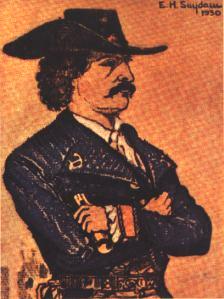Jean-Claude Laffitte Tibeau
by Joseph Geringer- Introduction - Players -
- Campaigns - Contribute -
![]()
- Introduction - Players -
- Campaigns - Contribute -
![]()
He has been called "The Corsair," "The Buccaneer," "The King of Barataria," "The Terror of the Gulf," "The Hero of New Orleans". At three separate times, U.S. presidents have condemned, exonerated and again condemned his actions. He is known for his piracy in the Gulf of Mexico, and lauded for his heroism in the Battle of New Orleans. Each personae seems to balance the other. He hated being called "pirate," for, as he saw it, he was a "privateer" serving an economic purpose in an economically frugal time in a new country that needed to economize. When he at last sailed away from American shores, he felt betrayed by a country that didn't understand the difference.
He was Jean Lafitte.

From the Gulf of Mexico through a vast uncharted maze of waterways to New
Orleans, his name was legend even in his day. Entrepreneur and astute
diplomat, he took an island-full of bloodied seafarers, rovers and fishermen
and turned them into an organization of buccaneers, smugglers and
wholesalers. From the ships they plundered off the Caribbean Coast and in
the Atlantic he and his "crew of a thousand men" kept a constant cargo of
black-marketed and very necessary provisions (including Negro slaves, a very
important "commodity" to the early South) moving through the Mississippi
Delta to help feed and clothe a part of the nation that the government
overlooked. As a result, he won the praise of the local rich and poor alike.
He never attacked an American ship. A man without a country, he nevertheless
respected the constitution of American ideals and hoped that what he called
his "kingdom by the sea" might someday meld into like ideals.
His self-made kingdom, from the Gulf of Mexico through the villages and
plantations to and including New Orleans, was a part of an untamed
wilderness that came as part of the package called the Louisiana Purchase of
1803. This delta was a new and lusty territory, overgrown with willows and
wildlife. Within its miles and miles of marshlands a man could get lost and
wander until he maddened and died of starvation. Unlike anything the
government knew; the topography, coupled by its habitation of misunderstood
Cajuns and Creoles, confused and perplexed Washington decision makers. Much
more, overcome with other, deepening international problems, the nation more
or less abandoned this wetland with its foreign cultures to fend for itself.
Lafitte's commerce of merchandise -- of cloths and linens, spices and
trinkets, furniture and utensils -- sold at discount prices, avoiding high
tariffs, to the grateful citizens of New Orleans. In short, Lafitte's
piratical methods, despite their negative connotation, proved to be a
survival factor for what was to become a major American city.
And then came a new territorial governor who decided that it was not
conventional to let an outsider -- let alone a notorious pirate -- become a
part of the blossoming American texture. Harassment and imprisonment
followed, even destruction of Lafitte's Valhalla. But, the governor and the
rest of burgeoning America were to learn that Lafitte's importance to this
new territory meant much more to him than his own personal prosperity. When
men were needed to keep New Orleans and the entire Mississippi River from
enemy hands, Lafitte -- despite the chastisement and near ruination he faced
from American mediators -- stepped forward to defend them.
Many stories have been told of Lafitte. To quote author Jack C. Ramsay, Jr.
from his excellent and concise Jean Laffite, Prince of Pirates, "Some
considered him a rapacious rogue, a man of unmitigated violence. Others,
many of whom were young women, regarded him as a charming person. He was
seductive, perhaps deceptive, but always elegantly gracious."
He writes that contemporaries described "(Lafitte) as 'graceful and elegant
in manners...accomplished in conversation.' And yet this was the man who was
often described in very different terms as the 'Prince of Pirates' or the
'ferocious' head of 'desperadoes.'"
Lord Byron sketched a poem about him even in his day. Countless books have
been written about his adventures. He has inspired many moves, the finest
being Cecil B. DeMille's classic, The Buccaneer. There is a national park
named after him, and along the Mississippi below New Orleans sits the City
of Jean Lafitte. To some, however, he is still a pirate.
But -- pirate, thief, swordsman, businessman or savior, Lafitte's legend
grows. Complex in nature, shrouded in mystery, and often painted in splashes
of color, he lives on in the role of auspicious hero.